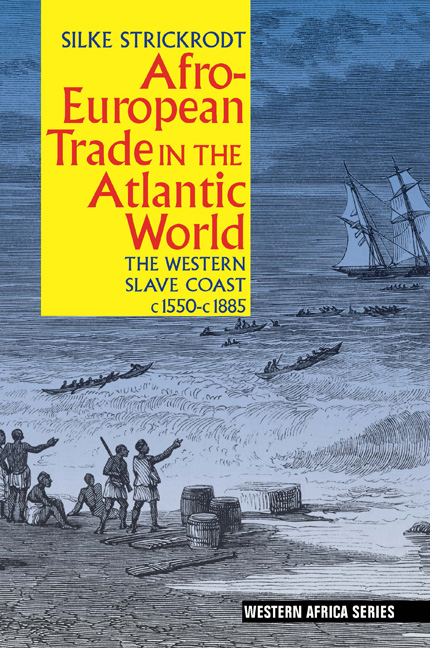Book contents
- Frontmatter
- Dedication
- Contents
- List of Maps
- List of Abbreviations
- Acknowledgements
- Map
- Introduction
- 1 The regional setting
- 2 The Atlantic connection: Little Popo & the rise of Afro-European trade, c.1600 to 1702
- 3 The era of the warrior kings: 1702 to 1772
- 4 The era of the traders: 1772 to c.1807
- 5 Disintegration & reconstitution: Political developments, 1820s to 1870s
- 6 From slaves to palm oil: Afro-European trade, c.1807 to 1870s
- Epilogue: The colonial partition & its consequences, 1870s to c.1900
- Bibliography
- Index
4 - The era of the traders: 1772 to c.1807
Published online by Cambridge University Press: 05 May 2015
- Frontmatter
- Dedication
- Contents
- List of Maps
- List of Abbreviations
- Acknowledgements
- Map
- Introduction
- 1 The regional setting
- 2 The Atlantic connection: Little Popo & the rise of Afro-European trade, c.1600 to 1702
- 3 The era of the warrior kings: 1702 to 1772
- 4 The era of the traders: 1772 to c.1807
- 5 Disintegration & reconstitution: Political developments, 1820s to 1870s
- 6 From slaves to palm oil: Afro-European trade, c.1807 to 1870s
- Epilogue: The colonial partition & its consequences, 1870s to c.1900
- Bibliography
- Index
Summary
For the period from 1772 to the abolition of the slave trade there is an exceptional abundance of documentation on the events on the western Slave Coast, which reflects its increasing importance in Afro-European trade. The region's rise in the trade had important repercussions for the communities there, shifting the power balance between the Ge king at Glidji and (African) traders in the coastal settlements in favour of the latter. This was the era of the traders, most importantly Lattie (d.1795), whose commercial success, new wealth and power was symbolised by the new, multi-storey houses that began to appear in the coastal settlement.
Little Popo, Anlo and the Danes, 1772 to 1792
In early 1772 the Danes established a lodge at Little Popo. This must have been very desirable for Little Popo, given the difficulties it faced in its struggle against Anlo at that time. As noted in the previous chapter, in 1772 these difficulties resulted in loss of control over Keta, which then allied with Anlo in its attack on Aflao. This was against the background of the Asante invasion of Akyem, Little Popo's ally on the Gold Coast against Akwamu, and Anlo's alliance with Akwamu. In the same year, Little Popo concluded a peace treaty with Dahomey, presumably in consequence of these difficulties on the western border. A European lodge meant supplies of firearms and gunpowder, access to credit and profits from trade which could be used towards war expenses. According to Biørn, reporting later in the century, the Danes also assisted Little Popo with money loans for their wars. Although he does not give particular dates and has a tendency to exaggerate, Danish support of Little Popo in this period seems likely enough. For the Danes, this was an opportunity to expand their influence in the region, especially as Little Popo was not in the position to be as assertive in negotiations with the Europeans as it had been at the time of Rømer's meeting with Ashampo in the 1740s.
- Type
- Chapter
- Information
- Afro-European Trade in the Atlantic WorldThe Western Slave Coast, c. 1550–c.1885, pp. 134 - 156Publisher: Boydell & BrewerPrint publication year: 2015

